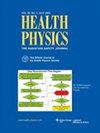H*10-TMFD与ROSPEC, Eberline和Ludlum探测器系统的超低至中等辐射水平中子剂量测量。
摘要
摘要:H*10中子剂量法(不同于伽马剂量法)需要考虑中子能谱,因为在热到快的能量范围内,权重因子有20倍的变化,而且中子辐射场剂量率范围从宇宙到~。在核实验室/加工厂中,从01 μSv -1到10-200 μSv -1,在核反应堆环境中达到104 μSv -1以上。本文讨论了采用新型H*-TMFD光谱学传感器系统进行的涵盖热到快能量的光谱加权中子剂量测量与采用最先进的srns旋转光谱仪(ROSPEC)的中子剂量测量系统以及非光谱Eberline ASP2E(“Eberline”)和Ludlum 42-49B(“Ludlum”)测量仪器的测量结果的比较。H*-TMFD使用2.48×1010 Bq 137Cs源验证了γ盲。萨凡纳河核解决方案公司(Savannah River Nuclear Solutions, SRNS)低散射设施中所有中子源均已关闭的本底剂量率估计为0.005 μSv h-1。采用高强度(1.4 × 109 n s-1) 252Cf源进行中高辐射场试验,总数据采集时间为~0.15 h, Eberline(非光谱)、Ludlum(非光谱)和光谱h *- tmfd仪器的预测剂量率分别为~170 μSv h-1、~200 μSv h-1和~ 120 μSv h-1。ROSPEC值测得的等效光谱(SRNS) H*10剂量率为130 μSv H -1,在H*10- tmfd测量值的10%范围内。采用~ 1.6 × 103 n s-1 252Cf裸中子源进行了超低强度辐射场试验,在~18 h的采集时间内,Eberline计测得~1 m处瞬时剂量/计数率为0 μSv h-1,脉冲积分剂量率为0.034 μSv h-1。相比之下,H*- tmfd面板位于252Cf源的直接视线0.22 m处,在1.8 H的采集寿命时间内测量到~0.4 μSv H -1(在+/- 5%范围内),其光谱与裸252Cf源的光谱完全匹配。H*TMFD预测值为~0.4 μSv H -1,与LLNL公布的~0.37 μSv H -1(强度/距离按1/r2定律修正,1 μg 252Cf源在1 m处为25.5 μSv H -1)相差10%;以及从使用ICRP 74转换系数和MCNP代码模拟。正如预期的那样,对于252Cf裸源,H*TMFD测量的超热中子能量相关剂量率远低于总剂量率的1%。对于~0.01 μSv H -1的中子辐射场,ROSPEC测量H*10剂量率估计需要7+ d,而使用H*TMFD则需要不到2 H。证明了在测量模式下使用单个CTMFD在2-3 min内测量H*10剂量率(nSv H - to μSv H -1)的可行性。Abstract: H*10 neutron dosimetry (unlike gamma dosimetry), requires consideration of neutron energy spectra due to the 20× variation of the weight factor over the thermal-to-fast energy range, as well as the neutron radiation field dose rates ranging from cosmic, ~.01 μSv h -1 levels to commonly encountered ~10-200 μSv h -1 in nuclear laboratories/processing plants, and upwards of 10 4 Sv h -1 in nuclear reactor environments. This paper discusses the outcome of the comparison of spectrum-weighted neutron dosimetry covering thermal-to-fast energy using the novel H*-TMFD spectroscopy-enabled sensor system in comparison with measurements using state-of-the-art neutron dosimetry systems at SRNS-Rotating Spectrometer (ROSPEC), and non-spectroscopic Eberline ASP2E ("Eberline") and Ludlum 42-49B ("Ludlum") survey instrumentation. The H*-TMFD was validated for gamma blindness using a 2.48×10 10 Bq 137 Cs source. The background dose rate in Savannah River Nuclear Solutions' (SRNS) low-scatter facility with all neutron sources withdrawn was estimated at 0.005 μSv h -1 . From moderately high radiation field tests conducted with the high intensity (1.4 × 10 9 n s -1 ) 252 Cf source and a total data collection time of ~0.15 h, the predicted dose rates from Eberline (non-spectroscopic), Ludlum (non-spectroscopic), and spectroscopic H*-TMFD instruments were found to be: ~170 μSv h -1 , ~200 μSv h - , and ~ 120 μSv h -1 , respectively. The equivalent spectroscopic (SRNS measured) H*10 dose rate from ROSPEC value is 130 μSv h -1 , within 10% of H*10-TMFD measurement. Tests conducted for ultra-low intensity radiation field used a ~ 1.6 × 10 3 n s -1 252 Cf bare neutron source for which over a collection time of ~18 h, the Eberline meter measured an instantaneous dose/count rate of 0 μSv h -1 and a pulse-integrated dose rate of 0.034 μSv h -1 at ~1 m. In contrast, the H*-TMFD panel located 0.22 m in direct line of sight of the 252 Cf source spectroscopically measured ~0.4 μSv h -1 (within +/- 5%) over 1.8 h collection live time-with which spectrum matched perfectly to that of a bare 252 Cf source. The H*TMFD predicted value of ~0.4 μSv h -1 was cross-checked and found to be within 10% of LLNL's published value of ~0.37 μSv h -1 (intensity/distance corrected via 1/r 2 law of 25.5 μSv h -1 at 1 m for a 1 μg 252 Cf source); as well as from use of ICRP 74 conversion coefficients and MCNP code simulations. As expected, for a bare 252 Cf source, H*TMFD measured epithermal neutron energy-related dose rates are well below 1% of the total dose rates. For ~0.01 μSv h -1 neutron radiation fields, ROSPEC measurements for H*10 dose rates are estimated to take 7+ d, vs. under 2 h with the H*TMFD. The feasibility of using a single CTMFD in survey mode for H*10 dose rate (nSv h - to μSv h -1 ) measurements within 2-3 min is demonstrated.

 求助内容:
求助内容: 应助结果提醒方式:
应助结果提醒方式:


